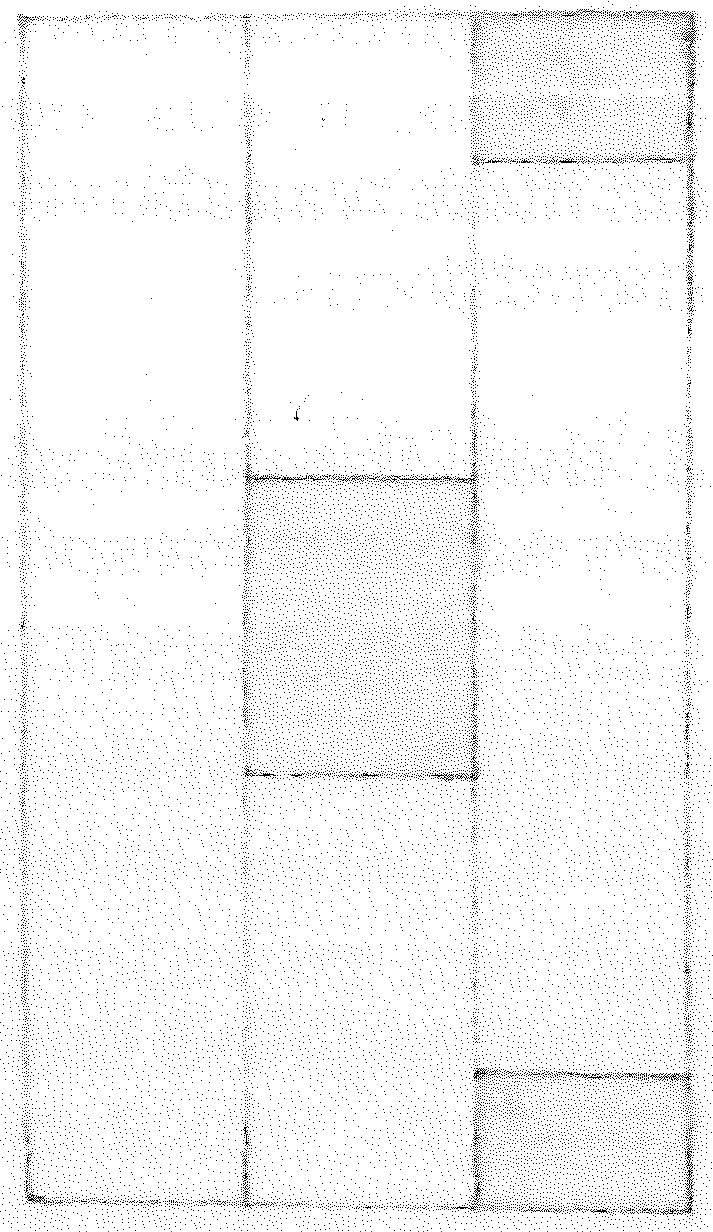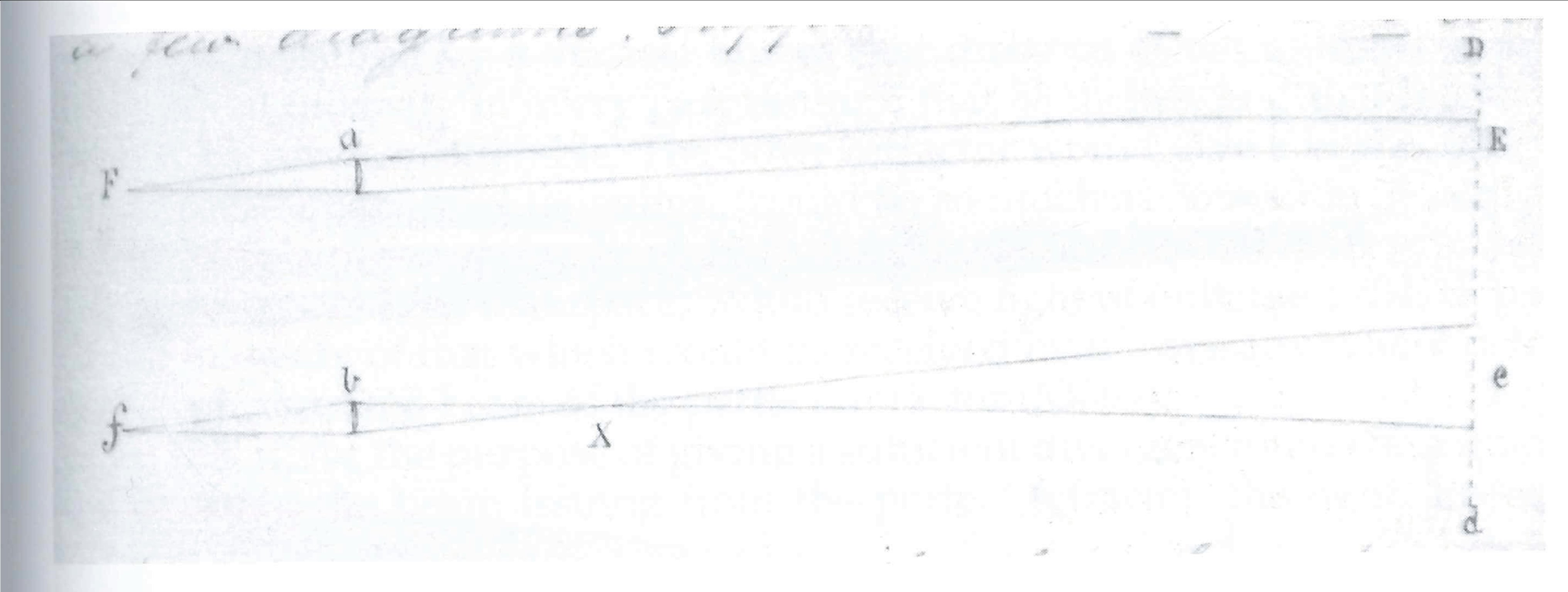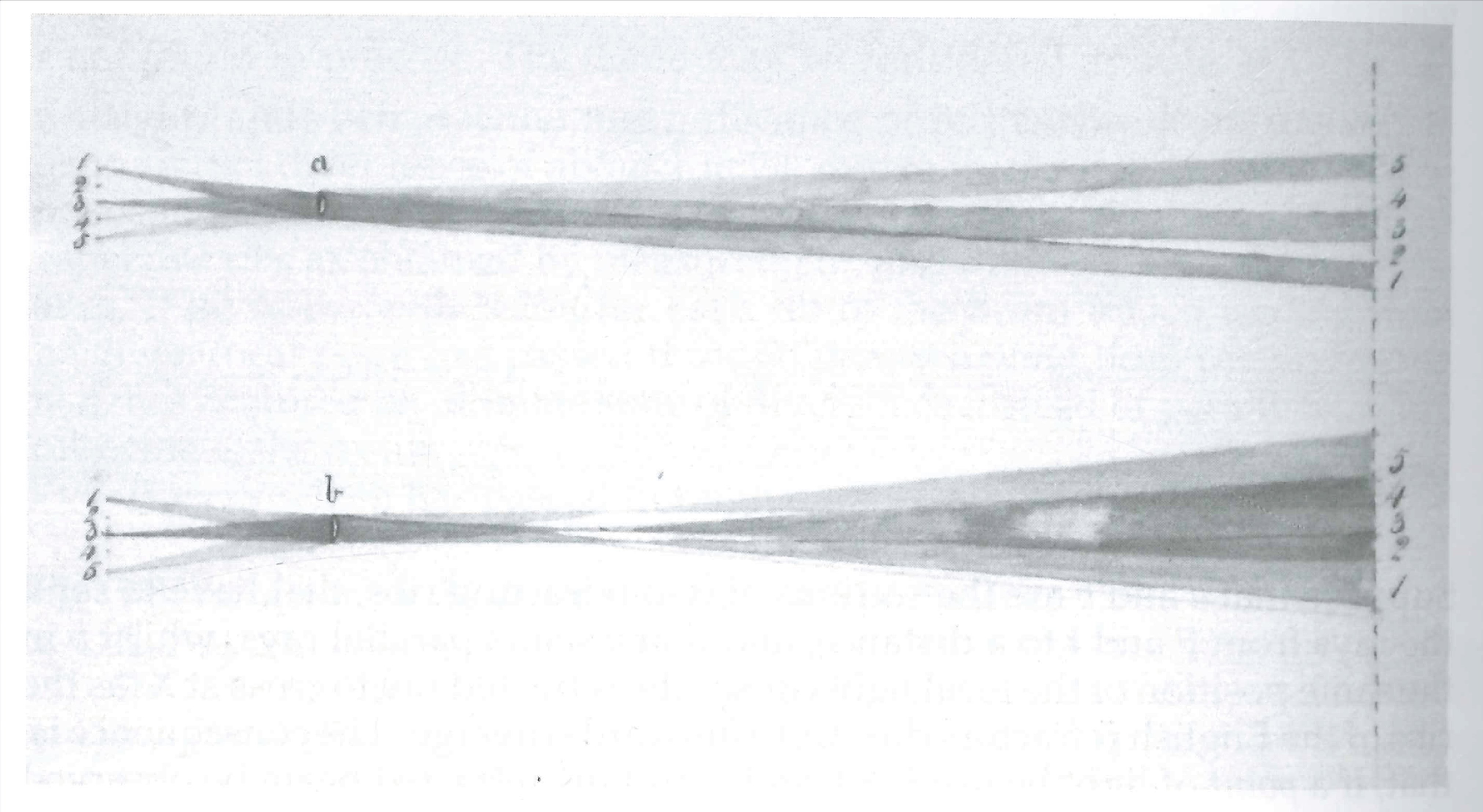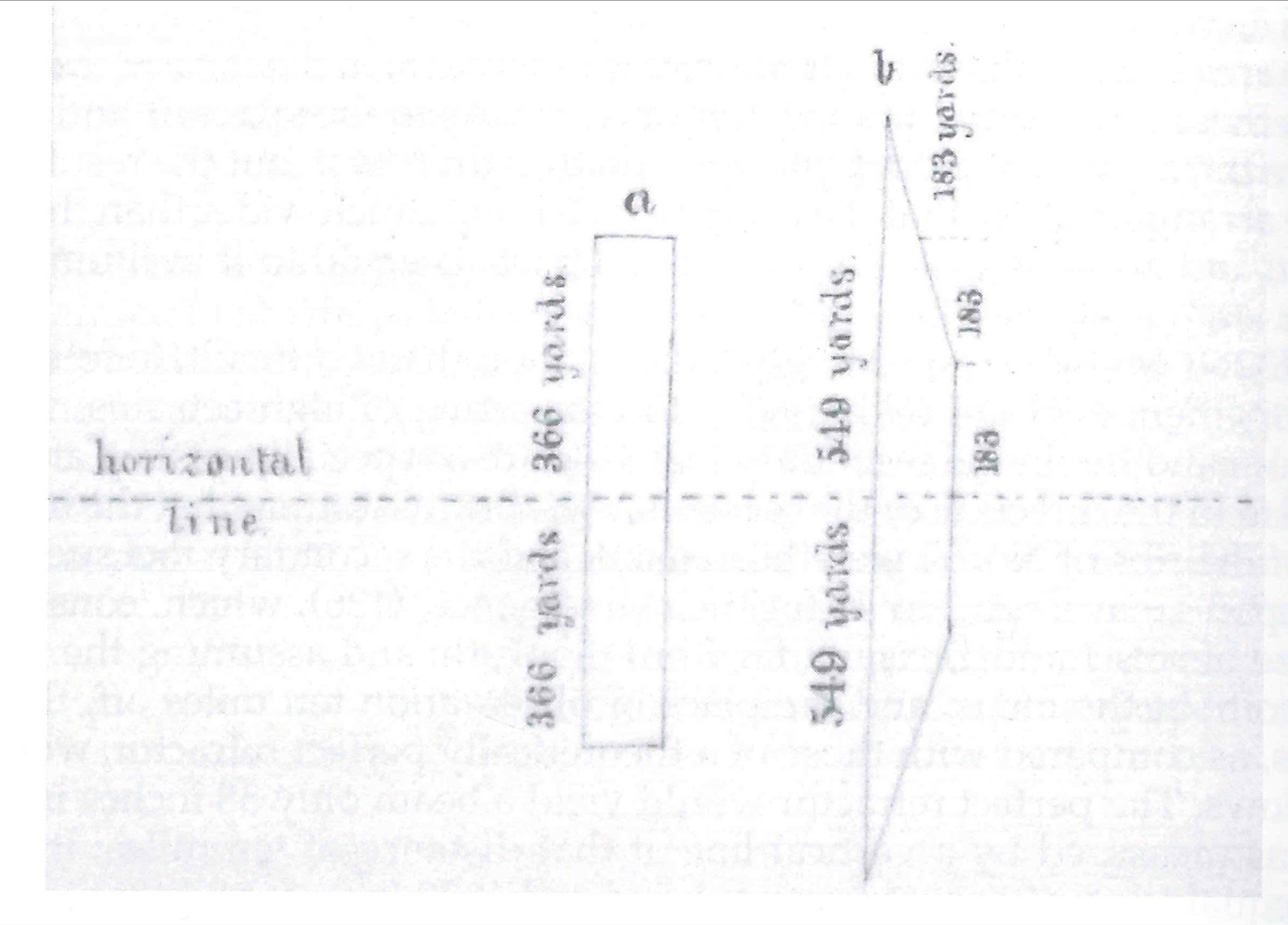Faraday report to Trinity House 16 October 1840
Report of Professor Faraday on the comparative qualities of refractors of French and English manufacture, dated October 1840.
To the Master, Deputy Master1, and Elder Brethren of the Trinity House,
My Lords and Gentlemen,
113. By your kindness I have had the opportunity which I desired (81. 95), of comparing the effect of the French and of two English first class refractors at Purfleet, observing them from the Trinity Buoy Wharf at Blackwall.
114. On two evenings the French refractor <(77)> and the English first class refractor No. 58. <(70)> were compared. The refractors were attached to different sides of the frame at Purfleet and brought to bear alternately upon the Wharf at Blackwall for certain short regular periods; the same four-wicked lamp in the same state being used as the source of light for both:- the lights, therefore, were not seen together, but in succession. On the first night an error in position of the refractors, during part of the observations, occurred; but when that was corrected the power of the light, as seen in any one of the four vertical columns <(40)> of the French refractor or in the English refractor at this distance of ten miles, appeared to me, to be nearly the same (135).
115. It is acknowledged to be very difficult to judge accurately of the proportionate power of two lights seen at once, or even of deciding, always, whether one is better than the other, except from the result of many observations; and besides this difficulty, there were two other interfering circumstances in the present case, which could not be set aside. The one was, that the lights could not be seen together, but only in succession; and the eye very imperfectly compares an impression that is past with one that is present. The other was, that on bringing either refractor to bear on the place of observation, the light was not so good at the beginning of the period of it’s duration of five minutes as at the end; so that the succeeding light generally appeared worse than the preceding light, and any one light grew better as it continued in sight. I attribute the effect to the circumstance, that, the lamp stood on the revolving frame supporting the refractors, and that when this was moved, to change one refractor for another, a portion of oil was shaken down from the feeder of the lamp, which, by deluging and cooling the cotton wicks, did, for a short time, actually cause a diminished flame.
116. These and the following observations were, upon every occasion, honored by the presence of the Deputy Master, and some of the Elder Brethren; for which reason I should not have ventured to give my own opinion of the lights, in a paper which had to come before those who are the only competent judges, were it not that I did not feel myself at liberty to withhold it from their judgment.
117. On another occasion the French refractor was compared with the English first class refractor No 54. <(73)> at the same stations and distance; but, by the care and direction of the Deputy Master, the advantage was obtained, of comparing both these with the fixed light of an Argand lamp in a Parabolic reflector of the usual size and arrangement, this being placed outside of the lighthouse, at the distance of 30 or 40 feet, so as to throw it’s constant light to Blackwall, the axis of the beam being directed to the Wharf. Thus either of the refractor lights could be seen at the same time with the reflector light; and the two refractor lights, though not seen at once, could be better compared with each other by their joint relations to this constant standard.
118. In the first place the French refractor was decidedly superior to the English refractor No. 54, through more than thirty alternations of their light. I think no doubt could remain of this fact (121).
119. In the next place, the reflector light was much superior to either the English or the French refractor lights, during the whole of the night. I think it surpassed the French refractor light more than that did the light of the English refractor. I expect that the reflector light was at it’s best.
120. In the third place arrangements were made, so that the English refractor No.54. being supposed to be divided by vertical lines into three portions, the first portion was left in its usual and proper state, but one fourth of each of the other portions were thrown out of action by opaque screens; this fourth being taken from the middle of the second portion and from the two ends of the third portion.

These three parts were then compared with each other and with the reflector. The difference between the light, when the whole of the refractor was in use, and that of either of the parts where only three-fourths were in use, was very evident, having the reflector as a constant standard. I could not distinguish any difference between the light of either of the two portions which had been screened; which as far as it goes, would imply that the refractors were as powerful in their action at the upper and lower edges as in the middle.
121. I think the light of the French refractor as much surpassed the English refractor No. 54, in it’s proper state, as this refractor did itself after one fourth of the light had been shut off by the opaque screens, (120).
122. Thus the comparison has been made in this very practical manner between the French refractor and two English refractors, and the result is by no means so much to the disadvantage of the latter as I had expected; or as I imagine the French philosophers would expect, judging from the very superior accuracy of their work. That their work is very superior I have tested, since my former reports, by exposing the French refractor and also the English refractor No. 54, to the parallel rays of the sun, and thus comparing them with a similar trial, made on a former occasion, with the English refractor No. 58. <(82)>. In that case the solar focus of No. 58 was found to be, for the two middle and principal ribs, 31 inches instead of 36½ inches; and these were not together but 1½ inches or more apart; the foci of the other ribs again being separated from these.
123. The English refractor No. 54 being put properly into the sun’s parallel rays, gave the distance of the foci of the two principal ribs as 31 inches nearly, instead of 36½ inches. The foci of the other ribs were, generally, shorter still, but were not individually ascertained. On ascertaining the distance to which the different beams of the different ribs converged, to produce what may be called the best general focus, it was found to be at nearly 36 inches from the refractor; but the beam there was above two inches wide, so imperfect was the concentration to a general focus.
124. On trying the four portions of the French refractor (40. 77.) in a similar manner, it was found, that, the particular focus of each rib and the general focus of all the ribs, very nearly corresponded. The distances were for the four portions 36¼, 36¾, 37, and 37 inches; all of which closely approximate to 36½ inches; and the width of the beam at this focal distance was from half an inch to three quarters of an inch, instead of being above two inches as with the English refractor, No. 54.
125. An illustration of the comparative degree of perfection of the work in the French and English refractors, which every one can understand, is obtained, by putting a sheet of paper, covered by large diagonal lines behind the refractors, about two feet from them, and then looking at it from a distance of 8, 10, 12, or 20 feet in front. The effect will shew that whatever the relative value of the refractors in a practical point of view, the workmanship and arrangement are very different.
126. On considering this great difference in quality, and the probable reason why it made so little difference of effect in the practical result, where, I had certainly feared a much greater influence, (81. 95), I was led, ultimately, to look for the compensating cause in the great size of the flame used, corresponding in fact to the size of the solar focus just observed (123) with the English refractor; and this is I believe the true reason why a greater difference is not found in practise. The flame may be considered as at least 1½ inches in height, and, being at the mean distance of 36½ inches from the refractor, it gives a divergence of about 1 in 24, due to its magnitude. Now taking the secondary foci of frame No 54, as already given <(73)>, and the widths of the respective ribs as obtained by measurement, and dividing the former by the latter, it gives the expression for each rib of the beam which issuing from the given focal point has passed through it, and having been over refracted by it, has acquired an ultimate state of divergence instead of parallelism. The following is the result.
The ray which has passed through

127. So all these divergences are less than the divergence consequent upon the size of the flame, that being as before said 1 in the distance of 24; and with the principal ribs as 3, 2, 1, 11, 12, 13, 14 it is only about half the divergence due to the size of the flame. Therefore, though, by their respective differences, they may tend to make the light, at points taken in the same vertical line across the beam at a given distance, differ from each other, yet it is still possible and probable, that the light in the middle of the beam, i.e. in the horizontal line, will be as good as that from a refractor, which, in respect to its secondary foci, is as perfect as the French refractor; provided the mean direction of the rays, or the medium rays <(48)>, are nearly parallel and horizontal.
128. This will be easily comprehended by a few diagrams.

Suppose that a and b are the sections of two refracting ribs, that have to send the rays from F and f to a distance; and that a sends parallel rays, whilst b in the same position of the focal light causes the refracted ray to cross at X (as the ribs of the English refractors do), and afterwards diverge. The consequence is, that, if a point of light be used at F and f, and the refracted beam be observed at the distance D.d. the rib a will there give a certain compressed beam of a certain intensity, whilst the rib b will give a beam three times as thick or extensive in vertical measurement, but of only one third the intensity; and so an eye placed at E and e in the horizontal plane would see only one third of the light from b that it would from a.
129. But if the light at F and f, instead of a mere point, were a vertical line, its dimension being increased that the great general beam should have a sufficient degree of divergence for practical purposes, then those points of light, above and below the true focal point, would yield beams, which, ultimately, would pass to positions above and below E and e respectively;- but the effect with the perfect rib a would be to increase the divergence only, the intensity at great distances being scarcely at all affected; whereas, with the other rib b, the effect would be to increase both divergence and intensity, the latter being the result of the extensive overlapping of the refracted diverging beams.
130. This is easily seen by the following figures;- for let a and b be the same refractors or ribs as before, and 1, 3, 5, at F and f similar points of light taken from different parts of a plane, elongated upwards and downwards from the focal point. Then the resulting beams from 1, 3, 5 at F with rib a would fall on to 1, 3, 5 at the distant place of observation D, and supply these places

with light equal in intensity to what before fell on E (128.) at the same distance; and if luminous points occurred also at 2 and 4 at F their beams would fall on the vacant spaces 2 and 4 at D and the whole space from 1 to 5 at D would be filled by a diverging beam, having the same intensity of light in every part, as was produced originally at 3 only, with a single luminous point in the focus (128).
131. With the rib b the effect will be as follows;- each of the luminous points 1, 3, 5 at f will send a beam, the medium ray of which will be at 1, 3, 5 at d, respectively, as with the rib a; but because these are diverging beams, (128) they will overlap, in the manner, and to the extent shewn; and if other rays proceed from 2 and 4 at f their beams will produce a similar illumination at 2 and 4 at the place of observation at d. The overlapping of these beams at the place where the light is observed, I have endeavoured to shew by the short coloured vertical lines. Wherever three of these correspond to the same space, as at the spaces 2, 3, and 4 at d, the light is as intense as for the corresponding spaces 2, 3 and 4 belonging to the perfectly acting rib a; for though the beams from b are only one third the strength of those from a; in the former case, three fall on these spaces, and in the latter only one . As to the spaces 1 and 5, they are one third weaker in their illumination by b than by a. But the result of the whole arrangement is, that the beam from b is not much wider than the beam from a, and at the middle and horizontal parts is equal to it in illuminating power.-
132. It would be exceedingly tedious, though not difficult, to follow this developement [sic] out with a refractor consisting of eighteen ribs, varying one from another in the secondary foci distances; especially as they are irregular also in the direction of the medium rays; but, assuming that the medium rays of the ribs of No. 54 were horizontal, and the secondary foci such, as to give upon an average 1 in 48 for their divergence, (126), which, considering the size of ribs 1 and 11, is not far from the truth; and assuming the light to be a point at the focus, and the place of observation ten miles off, then the results, as compared with those of a theoretically perfect refractor, would be as follows. The perfect refractor would yield a beam only 38 inches in thickness, as measured by a vertical line at that distance of ten miles; it would have equal intensity in every part through that 38 inches, and that intensity would be very considerable. The other refractor would give a beam, which, at the same distance of ten miles, would be as much as 366 yards in vertical thickness; (because of the divergence due to inaccurate workmanship;) and the eye any where in that space, would receive light of only the 1/347th part of the intensity of that which would be received by the eye any where in the more concentrated beam of the perfect refractor (63. 64).
133. If, for the purpose of giving a sufficient divergence and consequent thickness to the beam issuing from the perfect refractor, the light, instead of being a mere point, was a line 1½ inches high, (as is in fact the expedient employed in practical applications <(68)>,) then the perfect refractor would yield a beam extending 366 yards above the horizontal line at the place of observation; and, if not intercepted by the earth &c.- as much below it; through this space the light would be of uniform intensity. The other refractor representing No. 54 would have a beam extending 549 yards above the horizontal line and as much below it; of this, the first 183 yards each way upwards and downwards would have the same brightness as with the perfect refractor, and from the extremity of that distance the intensity would go on gradually diminishing to the end of the 549 yards. At the distance of 366 yards, the light would be half as intense as at the same distance from the horizontal line with the perfect refractor. The accompanying diagram may serve to express the relative condition of these beams;

the equal width of a indicating the equal intensity of the light given by the perfect refractor, over the whole width of it’s beam; and the varying width of b, serving to shew the varying intensity of the more extended beam from the refractor b.
134. Believing that the inferior workmanship of the English refractors, as compared to the French, had, in the observations made (114. 117.), in this manner been compensated for by the size of the flame, I endeavoured to use a small focal light for the purpose of verifying the principles advanced. A small Drummonds lime light would have been the fit object, (or perhaps a small convex reflector illuminated by the sun) but not having this, I used the central flame of the French lamp, and stopped off the light by a screen, except for about half an inch of the middle of the flame. This flame was visible both in the French and English refractors at the distance of ten miles; and I think the effect was much less in the English than in the French instrument. The light was, however, too feeble to allow of moderately sure conclusions.
135. It is very difficult, in practical trials, to judge fairly of the effect of two such different pieces of workmanship as the French and English refractors. Observation from one spot is by no means sufficient; for, from the irregularity of the English workmanship, points are likely to occur in different parts of the beam, and at different distances from the refractors, to which either much more or much less than the due proportion of light may be sent. If the observer be placed either in a fortunate or an unfortunate spot, it can only be by observation from numerous other spots, that the erroneous impression once made can be removed. Fortunately the divergence of the beams from each individual rib tends to counteract this effect. I make the observation with a reference to the relative effects observed with the French refractor and the English refractor No. 58. These were nearly equal (114), and yet the glass of the English refractor contains more striae and is far more coloured than that of the French instrument, and would be expected to stop more light. That it did come so near the French instrument, is, I think probably owing to the observations having been made from a spot fortunate for that instrument (127).
136. Thus it appears, that, when a large source of light is used, it is not of so much consequence to the action of a refractor that the individual ribs should send parallel rays as might have been expected. Still it is important to have the work as good as may be, for that never involves harm. With respect to the direction of the medium ray <(48)>, I am strongly of opinion, that, the adjustment should be such, as to give the medium rays from the different ribs, parallel with each other and with a horizontal line (127);- for, then, the greatest number of places and, also, the most important places from which the light will in practise have to be observed, will fall within the brightest part of the general beam.
137. I am very strongly impressed with the idea that the comparatively feeble effect of the Bude light at Orfordness as compared with that which was expected, is connected with the principles now developed (128.). The proximity of the bright part of the flame to the cottons and burner, is, no doubt, a great cause of the diminution of light, by shading the light from the lower part of the refractors. But if the ribs of these refractors give diverging beams, as the refractors from No. 51 to 58 do, then the vertical contraction of the bright part of the flame, which takes place in the Bude lamp, may have had a very serious influence upon the final results.
138. With respect to the mirrors of the Gibraltar apparatus, their concavity is such that the ray which issues from them has, I believe, in all of them less divergence than 1 in 24, or that due to the size of the flame (126); and in most cases much less divergence; so that the effect with them may be expected to be analogous to that of the different ribs (126, 136). Nor is this result affected by their different position to the flame, for it always subtends to them a width of more than 1½ inches. Still, I cannot but wish that the curvature were nearer to that which would give a parallel beam. The mode of adjusting and fixing them is one which allows of their medium rays being thrown accurately in a horizontal direction; so that, in that respect, there is nothing wanting but watchfulness to see that this is always effected2.
I have the honor to be | My Lords and Gentlemen | Your most obedient | humble Servant | (signed) M. Faraday
Royal Institution | 16th October 1840.
Please cite as “Faraday1315a,” in Ɛpsilon: The Michael Faraday Collection accessed on 27 April 2024, https://epsilon.ac.uk/view/faraday/letters/Faraday1315a